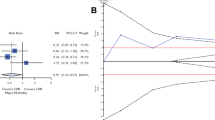Abstract
Background
Pancreatitis is one of complications after self-expandable metal stent (SEMS) placement. The purpose of this study was to evaluate risk factors for pancreatitis after endoscopic SEMS placement for malignant biliary obstruction (MBO).
Methods
We retrospectively reviewed 370 consecutive patients who underwent initial transpapillary SEMS placement for biliary decompression. The characteristics of inserted SEMSs were classified according to axial and radial force.
Results
Pancreatitis following SEMS insertion was observed in 22 patients (6%). All of them were mild according to consensus criteria. Univariate analysis indicated that injections of contrast into the pancreatic duct (frequency of pancreatitis, 10.3%), the placement of an SEMS with high axial force (8.3%), and nonpancreatic cancer (16.1%) significantly contributed to the development of pancreatitis, whereas female gender, a younger age, a covered SEMS, and a SEMS with high radial force or without a biliary sphincterotomy did not. In a multivariate risk model, SEMSs with high axial force (odds ratio [OR], 3.69; p = 0.022) and nonpancreatic cancer (OR, 5.52; p < 0.001) were significant risk factors for pancreatitis.
Conclusions
SEMSs with high axial force and an etiology of MBO other than pancreatic cancer were strongly associated with a high incidence of pancreatitis following transpapillary SEMS placement in patients with distal MBO.
Similar content being viewed by others
References
Knyrim K, Wagner HJ, Pausch J, Vakil N (1993) A prospective, randomized, controlled trial of metal stents for malignant obstruction of the common bile-duct. Endoscopy 25:207–212
Davids PHP, Groen AK, Rauws EAJ, Tytgat GNJ, Huibregtse K (1992) Randomized trial of self-expanding metal stents versus polyethylene stents for distal malignant biliary obstruction. Lancet 340:1488–1492
Isayama H, Yasuda I, Ryozawa S, Fujita N (2011) Results of a Japanese multicenter, randomized trial of endoscopic stenting for nonresectable pancreatic head cancer (JM-TEST): Covered Wallstent vs. double-layer stent. Dig Endosc 23:310–315
Kubota Y, Mukai H, Nakaizumi A, Yasuda K (2005) Covered Wallstent for palliation of malignant common bile duct stricture: prospective multicenter evaluation. Dig Endosc 17:218–223
Telford JJ, Carr-Locke DL, Baron TH et al (2010) A randomized trial comparing uncovered and partially covered self-expandable metal stents in the palliation of distal malignant biliary obstruction. Gastrointest Endosc 72:907–914
Kullman E, Frozanpor F, Soderlund C et al (2010) Covered versus uncovered self-expandable nitinol stents in the palliative treatment of malignant distal biliary obstruction: results from a randomized, multicenter study. Gastrointest Endosc 72:915–923
Cote GA, Kumar N, Ansstas M et al (2010) Risk of post-ERCP pancreatitis with placement of self-expandable metallic stents. Gastrointest Endosc 72:748–754
Kahaleh M, Tokar J, Conaway MR et al (2005) Efficacy and complications of covered Wallstents in malignant distal biliary obstruction. Gastrointest Endosc 61:528–533
Isayama H, Komatsu Y, Tsujino T et al (2004) A prospective randomised study of “covered’’ versus “uncovered’’ diamond stents for the management of distal malignant biliary obstruction. Gut 53:729–734
Cotton PB, Garrow DA, Gallagher J, Romagnuolo J (2009) Risk factors for complications after ERCP: a multivariate analysis of 11, 497 procedures over 12 years. Gastrointest Endosc 70:80–88
Freeman ML, Guda NM (2004) Prevention of post-ERCP pancreatitis: a comprehensive review. Gastrointest Endosc 59:845–864
Tarnasky PR, Cunningham JT, Hawes RH et al (1997) Transpapillary stenting of proximal biliary strictures: does biliary sphincterotomy reduce the risk of postprocedure pancreatitis? Gastrointest Endosc 45:46–51
Isayama H, Nakai Y, Toyokawa Y et al (2009) Measurement of radial and axial forces of biliary self-expandable metallic stents. Gastrointest Endosc 70:37–44
Cotton PB, Lehman G, Vennes J et al (1991) Endoscopic sphincterotomy complications and their management - an attempt at consensus. Gastrointest Endosc 37:383–393
Artifon ELA, Sakai P, Ishioka S et al (2008) Endoscopic sphincterotomy before deployment of covered metal stent is associated with greater complication rate: a prospective randomized control trial. J Clin Gastroenterol 42:815–819
Yoon WJ, Lee JK, Lee KH et al (2006) A comparison of covered and uncovered Wallstents for the management of distal malignant biliary obstruction. Gastrointest Endosc 63:996–1000
Isayama H, Kawabe T, Nakai Y, Komatsu Y, Omata M (2004) Covered metallic stents for management of distal malignant biliary obstruction. Dig Endosc 16:S104–S106
Nakai Y, Isayama H, Komatsu Y et al (2005) Efficacy and safety of the covered Wallstent in patients with distal malignant biliary obstruction. Gastrointest Endosc 62:742–748
Cotton PB, Connor P, Rawls E, Romagnuolo J (2008) Infection after ERCP, and antibiotic prophylaxis: a sequential quality-improvement approach over 11 years. Gastrointest Endosc 67:471–475
Freeman ML, Nelson DB, Sherman S et al (1996) Complications of endoscopic biliary sphincterotomy. N Engl J Med 335:909–918
Wilcox CM, Phadnis M, Varadarajulu S (2010) Biliary stent placement is associated with post-ERCP pancreatitis. Gastrointest Endosc 72:546–550
Loew BJ, Howell DA, Sanders MK et al (2009) Comparative performance of uncoated, self-expanding metal biliary stents of different designs in 2 diameters: final results of an international multicenter, randomized, controlled trial. Gastrointest Endosc 70:445–453
Weston BR, Ross WA, Liu J, Lee JH (2010) Clinical outcomes of nitinol and stainless steel uncovered metal stents for malignant biliary strictures: is there a difference? Gastrointest Endosc 72:1195–1200
Nakai Y, Isayama H, Togawa O et al (2011) New method of covered wallstents for distal malignant biliary obstruction to reduce early stent-related complications based on characteristics. Dig Endosc 23:49–55
Simmons DT, Petersen BT, Gostout CJ, Levy MJ, Topazian MD, Baron TH (2008) Risk of pancreatitis following endoscopically placed large-bore plastic biliary stents with and without biliary sphincterotomy for management of postoperative bile leaks. Surg Endosc 22:1459–1463
Banerjee N, Hilden K, Baron TH, Adler DG (2010) Endoscopic biliary sphincterotomy is not required for transpapillary SEMS placement for biliary obstruction. Dig Dis Sci 56:591–595
Author information
Authors and Affiliations
Corresponding author
Rights and permissions
About this article
Cite this article
Kawakubo, K., Isayama, H., Nakai, Y. et al. Risk factors for pancreatitis following transpapillary self-expandable metal stent placement. Surg Endosc 26, 771–776 (2012). https://doi.org/10.1007/s00464-011-1950-4
Received:
Accepted:
Published:
Issue Date:
DOI: https://doi.org/10.1007/s00464-011-1950-4




